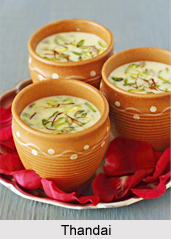 Thandai is a very popular Indian drink in North India made during festivals like Mahashivratri and Holi. It is a refreshing drink especially for summer which acts as a body coolant too. Thandai is a milk based summer drink which is synonymous with our Indian festival, Holi. The festival of colours is celebrated with much fanfare in North India and one of the special festive treats prepared on this day is Thandai. An exotic mix of spices, nuts and full fat milk go into the making of this cooling summer drink. Prepared during the hot summer months, this spiced milk mixture not only has many healthy benefits but also has a cooling effect on the body.
Thandai is a very popular Indian drink in North India made during festivals like Mahashivratri and Holi. It is a refreshing drink especially for summer which acts as a body coolant too. Thandai is a milk based summer drink which is synonymous with our Indian festival, Holi. The festival of colours is celebrated with much fanfare in North India and one of the special festive treats prepared on this day is Thandai. An exotic mix of spices, nuts and full fat milk go into the making of this cooling summer drink. Prepared during the hot summer months, this spiced milk mixture not only has many healthy benefits but also has a cooling effect on the body.
Ingredients for Thandai:
•Almonds - 1/3 cup
•Cashew Nuts - 2 tbsp
•Poppy Seeds - 1 tbsp
•Melon Seeds - 2 tbsp
•Fennel Seeds - 1/2 tsp
•Green Cardamom - 5
•Black Peppercorns - 3/4 tsp
•Sugar - 8 tbsp
•Milk - 1 and 1/2 litre
•Water - 3/4 cup
•Rose Essence - 1/2 tsp
•Saffron - few strands
•Pistachios - fistful, crushed
Method
 1. Soak almonds, melon seeds and poppy seeds in water for 2 hours.
1. Soak almonds, melon seeds and poppy seeds in water for 2 hours.
2. Boil milk, add sugar and allow it to dissolve. Once the sugar is dissolved, turn off heat and allow it to cool.
3. While milk is boiling, peel the soaked almonds and place in a bowl.
4. To this bowl, add the drained melon seeds, drained poppy seeds, cashew nuts, fennel seeds, pepper corns and green cardamom.
5. Grind all these ingredients to a paste. Add 1/4 cup of water and grind further to a smooth paste.
6. Add the ground paste to the milk-sugar mixture and mix well. Place lid and leave aside for 15 minutes.
7. In a large bowl, strain the mixture. Keep the strained liquid aside.
8. To the residue of almond spice mixture, add 1/2 cup water and strain again into the large bowl.
9. Add saffron strands and dried rose petals or rose essence to the strained liquid and mix. Chill in the refrigerator for at least 3 hours.
10. At the time of serving, pour into serving glasses.
11. Top with crushed pistachios, slivered almonds and 1 or 2 saffron strands.
12. Serve the Thandai chilled.
Notes for Thandai
One can also serve the Thandai without straining. A tablespoon of dried rose petals can be added at the time of grinding the ingredients.
Related Articles
Indian Beverages
Indian Food
Traditional Indian Beverages
Beverages in Vedic Period
Beverages in Mauryan Empire
Wild Almond Tree in India
Badam
Milk




















